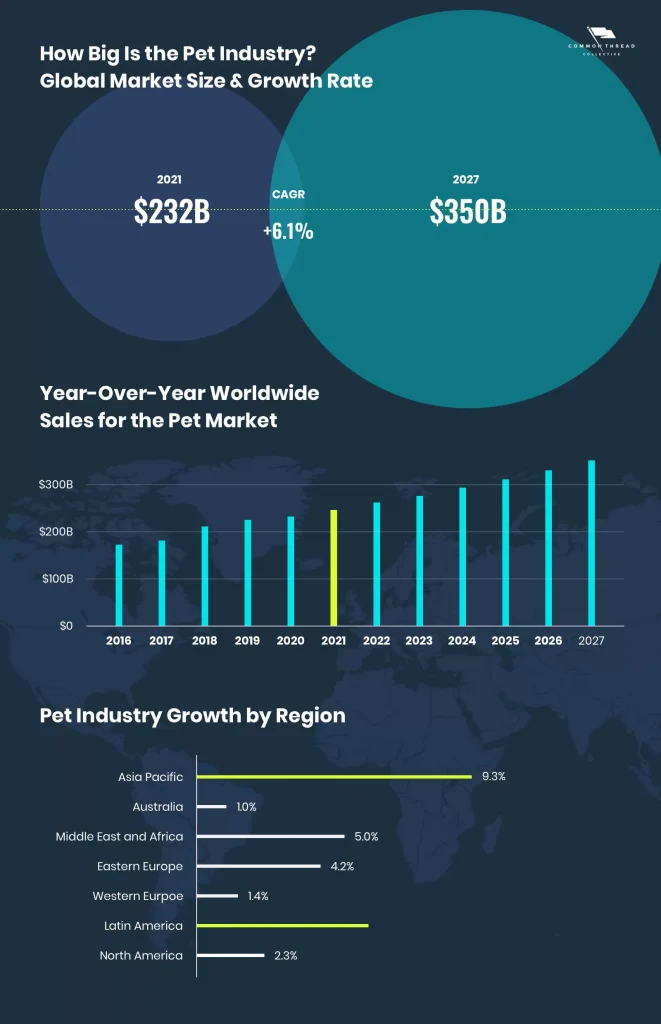Surges in sales. Immunity from the pandemic’s financial downturn. And an ecommerce market share outpacing online retail as a whole. By every metric, the pet industry in 2021 represents one of the most lucrative opportunities for online brands. Every metric … except one. Despite strong numbers, it’s a dog-eat-dog world with the biggest of the big devouring far more than their fair share.
Intense competition among retailers marks the pet food, pet care, and pet supplies landscape — especially mass merchandisers who are privy to high-volume sales, the luxury of lower margins, and scale. The top two US players, PetSmart and PETCO, account for nearly half of all online pet product revenue there. (UK data available from Statista here) Amazon’s debut into white-labelled pet food challenges start-ups lacking methods to address variable costs like supply-chain logistics and shipping.
What’s more, traditional retail giants like Walmart and Target are expanding their online presence — redefining the pet market and shoppers’ expectations. With real numbers and tested strategies, this guide provides an overview of the state of the pet industry broken into two parts along with tactical lessons from ecommerce brands doing it right.
Pet Industry Trends: Growth & Statistics in 2020, 2021, and Beyond
Mapping data across the pet industry is notoriously difficult. Unlike fashion marketing, health and wellness, and the beauty industry, no single source of market research exists.
Globally, the pet care market has grown from $216 billion in 2020 to $232 billion in 2021. An estimated 6.1% compounded annual growth rate (CAGR), will catapult that figure to $350 billion by 2027.

While North America and Western Europe are mature, they still offer possibilities for an uptick in consumer purchases relative to the growth experienced worldwide.
Space exists for the development of new products and especially new channels: an advantageous lifecycle stage for emerging brands to enter and thrive.
Within the ecommerce sector especially there is significant room for maturation, as customer preference for shopping for pet products on ecommerce sites is estimated to grow at 9.4% — a sizable increase over its already 13% market share.
1. The Boom of Ecommerce’s Pet Market
While retail stores have seen a slow increase in buying, the online pet market has nearly quadrupled since 2013.
With pet ownership rates continuing to rise, the target market for the industry as a whole will expand, allowing new penetration points.
Yes, the big-box pet stores are experiencing good fortune. But, to fear the competition is to miss the way forward.
For entrepreneurs eager to penetrate new markets, pet food and pet supplies are the second and third biggest ecommerce CPG categories across the industry. The promise of prosperity is acutely high within the natural foods, animal care, and supply sectors.
Within the ecommerce sector especially there is significant room for maturation, as customer preference for shopping for pet products on ecommerce sites is estimated to grow at 9.4% — a sizable increase over its already 13% market share.
Whether it’s a rise in the number of household pets or diversified shopping platforms — the result is an expansion of the global pet market. No surprise, the area of opportunity for businesses looking to expand market share in the pet industry is online.
2. Pet Ownership Demographics and Preferences
No longer do Baby Boomers represent the largest portion of pet owners; that title now belongs to Millennials. Pet brands who will win the future of the industry must understand how Millennials differ from the other generations.
Digital purchasing power cannot go without emphasizing the importance of marketing within that space. Millennials nearly double baby boomers’ time spent on social media — 90.4% of millennials are active social media users compared to 48.2% of Baby Boomers (eMarketer, 2019).
By nature of how users natively wield social, the pet category seamlessly fits within the realm of sharable content. Thus, retailers who meet millennials where they’re at can be a make-or-break difference for brands looking for competitive channel advantage.
In addition, competitive pricing, convenience, and personalization are blowing the brick-and-mortar house down.
The response: dual-channel retailing, faster fulfilment, improved cost controls, and advances in home delivery. Demand for high-quality products from millennials further contributes to industry profit because of the generally higher mark-ups of premium products.
Making this data actionable means examining ecommerce trends and statistics within three segments, each with its unique value propositions …
3. Data on Three Verticals within the Industry
(1) Pet Food Market
At $91.1 billion worldwide, pet food represents the single largest niche within the larger space. Within the United States 2020 market volume of $30.9M, most revenue is generated by the food segment, which also includes treats and supplements.
Add to this the potential for premium pet food products within the market segment. Natural and organic food products tend to come at a higher price tag, affording operators to earn greater markups.
An increasing penetration of retail sales has augmented the growth of the pet food market. At the same time, the availability of pet food on ecommerce platforms entices consumers with convenience and the stripping away of physical shopping constraints.
(2) Pet Care & Services
The pet services market includes grooming, boarding, training, and care.
Over the past five years, it has been the fastest-growing product segment under the industry umbrella. With more and more owners considering their pets as family, its rise is driven by interest in pampering and speciality services for furry family members.
Alongside it is the veterinary care industry, which has undergone growth as a result of mass household penetration.
Rising per capita income and growing pet adoptions for companionship lend to an increase in spending on pet care which will continue to boost the market.
Regardless of the distribution channel, brands within the pet care industry that offer premium services may see further gains.
Because households are obtaining higher incomes, they can afford premium discretionary services. It also affects the lifestyle of pet owners, affording them more ability to travel, thus increasing the importance of the boarding services segment.
(3) Pet Products & Supplies
With food and pet care holding the top two spots in terms of industry sales, there are more promising prospects within the pet supply market because it is slower growing and encompasses niche products like clothing, food bowls, collars, and carriers.
A key driver for this industry will be the wide range of availability of fashionable and multifunctional pet accessories.
Pet supplies are a leading industry category in the United States, with sales of approximately 4.54 billion U.S. dollars and positive sales growth of 2.7%.
Its share of revenue also spread due to the “pet parenting” trend, in which pet owners treated their pets as family members and started supplying them with complementary products. This segment accounted for an estimated 40.6% of total industry revenue in 2019.
Of those buying pet products, approximately 17% reported buying pet products online in 2017, up from approximately 13% in the previous year.
Pet supplies and accessories sold by retailers also encounter mounting competition not only from mass merchandisers but by smaller outlets because there are no regulations that limit their sales.
For online retailers, favourable economic conditions in the pet supply segment can be complemented through product innovation. Since mass-market brands offer goods with little differentiation, the spike in exclusive niche products will help diversify the current price competition.
In this way, niche product marketing will become mandatory for success for brands positioning themselves apart in the space.
4. Pets Stores, Retail, and Pop-Ups: Don’t Bite the Hand That Feeds You
PetSmart and Petco still hold the largest market share. Two retailers account for ~40% of the landscape, compared to more fragmented verticals like the home furnishings industry where 13 control 55%.
According to Pet Business’ Top 25 Retailers list for 2019, while PetSmart added a net total of 48 stores (versus more than 100 in 2017), Petco added a net total of 10 stores (versus 39 in 2017).
“Despite mounting competition from supermarkets, mass merchandisers and online retailers that offer similar products at greater convenience and competitive prices –traditional brick-and-mortar establishments have successfully positioned themselves as pioneers and exclusive providers of high-quality food and service offerings, such as grooming or daycare,” states the IBIS World Industry Report.
Meanwhile, digitally native pet brands are steadily gaining more market share.
Their success reflects how advances in technology within the human consumer retail market are driving change in the companion animal market as well.
None illustrate this shift more than …
5. Amazon: The Elephant Great Dane in the Room
With Amazon’s main website and third-party sellers taking up 35% of the online market share, pet startups are left to fight over the remaining food in the bowl.
Coupled with the launching of Amazon’s first private-label pet brand Wag, might have traditional retailers with their tails in between their legs. The Wag brand offers dry food, the highest moving category within pets, exclusively to its Prime members.
While Amazon’s scale and market share might seem daunting, it does offer a glimpse of hope for brands looking to enter the online pet space. Amazon’s success shows that there is money to be made in the ecommerce space for the pet industry.
It further affirms pet brands need to take things digital to succeed and gain more market share.





